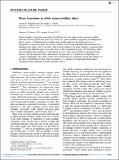| dc.contributor.author | Kalidindi, Arvind Rama | |
| dc.contributor.author | Schuh, Christopher A | |
| dc.date.accessioned | 2018-06-18T18:30:38Z | |
| dc.date.available | 2018-06-18T18:30:38Z | |
| dc.date.issued | 2017-06 | |
| dc.date.submitted | 2017-02 | |
| dc.identifier.issn | 0884-2914 | |
| dc.identifier.issn | 2044-5326 | |
| dc.identifier.uri | http://hdl.handle.net/1721.1/116375 | |
| dc.description.abstract | Grain boundary segregation can reduce the driving force for grain growth in nanocrystalline materials and help retain fine grain sizes. However, grain boundary segregation is enthalpically driven, and so a stabilized nanocrystalline state should undergo a disordering process as temperature is increased. Here we develop a Monte Carlo-based simulation that determines the minimum free energy state of an alloy with a strong tendency for grain boundary segregation that considers both different grain sizes and a large solute configuration space. We find that a stable nanocrystalline alloy undergoes a disordering process where grain boundary segregated atoms dissolve into the adjacent grains and increase the grain size as a function of temperature. At a critical temperature, the single crystal state becomes the most preferred. Using this method, we are able to determine how the grain size changes as a function of temperature and produce equilibrium phase diagrams for nanocrystalline alloys. | en_US |
| dc.description.sponsorship | United States. Army Research Office (Grant W911NF-14-1-0539) | en_US |
| dc.language.iso | en_US | |
| dc.publisher | Cambridge University Press | en_US |
| dc.relation.isversionof | http://dx.doi.org/10.1557/jmr.2017.188 | en_US |
| dc.rights | Article is made available in accordance with the publisher's policy and may be subject to US copyright law. Please refer to the publisher's site for terms of use. | en_US |
| dc.source | Prof. Schuh via Erja Kajosalo | en_US |
| dc.title | Phase transitions in stable nanocrystalline alloys | en_US |
| dc.type | Article | en_US |
| dc.identifier.citation | Kalidindi, Arvind R. and Christopher A. Schuh. “Phase Transitions in Stable Nanocrystalline Alloys.” Journal of Materials Research 32, 11 (May 2017): 1993–2002 © 2017 Materials Research Society | en_US |
| dc.contributor.department | Massachusetts Institute of Technology. Department of Materials Science and Engineering | en_US |
| dc.contributor.approver | Schuh, Christopher A. | en_US |
| dc.contributor.mitauthor | Kalidindi, Arvind Rama | |
| dc.contributor.mitauthor | Schuh, Christopher A | |
| dc.relation.journal | Journal of Materials Research | en_US |
| dc.eprint.version | Author's final manuscript | en_US |
| dc.type.uri | http://purl.org/eprint/type/JournalArticle | en_US |
| eprint.status | http://purl.org/eprint/status/PeerReviewed | en_US |
| dspace.orderedauthors | Kalidindi, Arvind R.; Schuh, Christopher A. | en_US |
| dspace.embargo.terms | N | en_US |
| dc.identifier.orcid | https://orcid.org/0000-0003-2854-650X | |
| dc.identifier.orcid | https://orcid.org/0000-0001-9856-2682 | |
| mit.license | PUBLISHER_POLICY | en_US |
